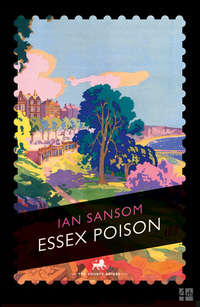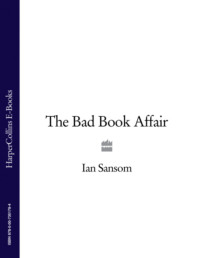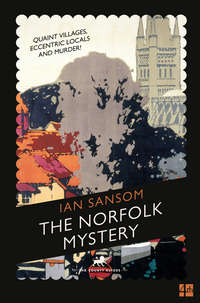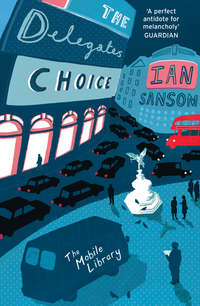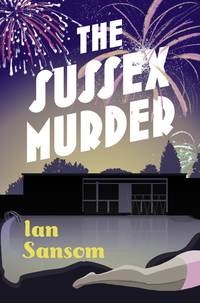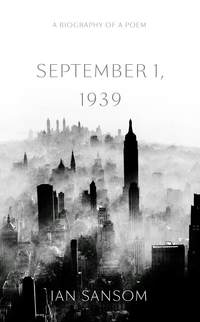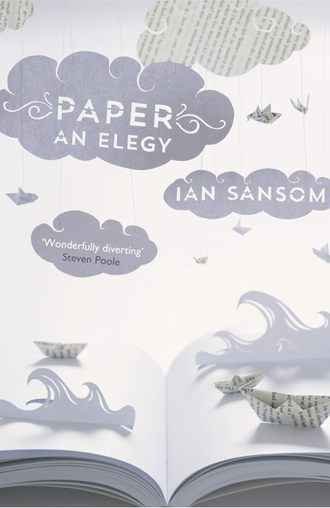
Полная версия
Paper: An Elegy
Even my own modest collection of Half-Inch Bartholomew maps, with their tweedy Edinburgh elegance, have a kind of satisfying thickness to them, a fullness, like a wooden jigsaw puzzle, or an old Bakelite radio, a reminder that things were somehow heavier and thicker, more substantial, in the old days. The past always seems to weigh more – because often it did. My Bartholomew maps, some of them over a hundred years old and of printed paper mounted on linen, barely show their age except for a little fraying at the edges, and still sit sturdily in the hand on long hikes, like Arthur Wainwright’s ubiquitous pipe, or a greaseproof wrap of sandwiches. It just seems natural to find one’s way using a printed map – presumably because for centuries people have indeed navigated their way with paper, so we have become accustomed to them guiding us towards our destination: map-reading another of our many ingrained paper habits. In an article in the Journal of Environmental Psychology in 2008, ‘Wayfinding with a GPS-Based Mobile Navigation System: A Comparison with Maps and Direct Experience’, Dr Toru Ishikawa, a cognitive-behavioural geographer at the University of Tokyo, found that pedestrians using GPS devices made more errors than those using paper maps (but that people using paper maps made more errors than those who were shown the route in person). Dr Ishikawa has also studied how people view art in museums using both audio-visual aids and traditional guidebooks and floorplans: those using the new technology tend to forget what they’ve seen quicker than those using the traditional guides. Good old paper, man’s best friend, trotting along beside us like a faithful retriever.
It can even be relied upon in virtual realms. In the Super Mario series of video games, for example – which includes the excellent Paper Mario, Super Paper Mario, Paper Mario: The Thousand-Year Door, and the spin-off Mario and Luigi series – part of the appeal and attraction is not only that Mario can fold up into a paper plane, and a paper boat, feats which are of course excellent and impressive in themselves, but also that he often navigates the bewildering virtual world with a trusty map in his white-gloved hand: an intrepid moustachioed explorer, Mario is also our guide. For home-made Mario-style mapping, an Italian self-styled ‘jedi architect and media master’ called Iacopo Boccalari has created a simple method for turning dull on-screen Google Maps into paper-looking on-screen Google maps (see www.iacopoboccalari.com), while MapsOnPaper.com, run by a Swedish design agency, will transform a screen-friendly map into a printer-friendly format. Paper remains the ghost in the machine. Metaphorically.
Literally. Recently, the increased availability of open-source data and mapping tools has allowed people to make their own maps: in the now customary Web 2.0 fashion, map consumers have become map producers. This new kind of map-making is sometimes called neo-cartography, and in 2004 a man called Steve Coast became one of the first digital neo-cartographers when he created something called OpenStreetMap (OSM), the Wikipedia of maps. Using a cheap hand-held GPS device, Coast set out to create a map that could be made freely available, without copyright restrictions, and that could be added to and edited by others. In the words of its mission statement, OpenStreetMap is ‘dedicated to encouraging the growth, development and distribution of free geospatial data and to providing geospatial data for anybody to use and share’. What’s amazing is that the using and sharing of geospatial data via OSM still requires paper in order to work effectively. Not everyone has the cutting-edge digital tools or cartographic instincts or training to be able to add meaningful details to digital maps, so various methods of contributing to OSM maps have quickly evolved, including the so-called Walking Papers method, which allows people to print OSM maps on paper, add details to them with a pen, and then scan them back onto the map using the OSM web-based software. It’s easy: we’re all neo-cartographers now. And, crucially, it isn’t just a hobby for wannabe geographers.

Map illustrating a historical event
Kibera is a massive slum in Nairobi, Kenya: estimates of its population range from 200,000 to more than a million. In 2008 the independent Map Kibera Project, organised by an Italian academic, Stefano Marras, began mapping Kibera using the Walking Papers method, with the aim of producing reliable, up-to-date maps for use by the inhabitants of this ever-changing city. Local children are trained in basic GPS technology, in order to be able to capture the geographical data of an area using handheld devices, and organisers and volunteers then print off A1-size maps using this data so that others can then use tracing paper and sets of coloured markers to add important details such as the location of markets, sewers, pathways and streams. This marked-up paper map is then photographed and copied to a computer, the original map is updated, and large numbers of the maps printed for distribution: a dynamic digital-paper-digital-paper flow.
This collaborative, hybrid form of digital/paper mapping has also been used successfully in disaster zones: in 2010 in the Pakistan floods, after the Christchurch earthquake in 2011, and currently in Haiti. Arguably there has been no enterprise quite like it since the English Society for the Diffusion of Useful Knowledge (SDUK) produced their cheap maps for working people – sold for a shilling – in the early to mid-1800s, and even then there was of course no sense in which the readers of the SDUK maps were also the producers. The hierarchical model of geographical data collection and distribution may have changed, but paper still has a role to play in the digital era: machines may make maps, but machines still run on paper.
Between the first maps being drawn in the sand and the new Golden Age of Google and OSM neo-cartography there have been centuries of men and women making maps not only on paper but on just about any kind of material, including stone, wood, and in the famous case of Charlemagne, plates of solid silver. Everyone knows that the first printed map in the Western world appeared in a 1472 edition of the dictionary of St Isidore of Seville, and everyone knows it was the Flemish cartographer Gerardus Mercator who in the late sixteenth century began making maps using a projection based on latitude and longitude (the considerable advantage of which is that it makes navigation easier, the considerable disadvantage of which is that it makes Greenland look bigger than China, and Europe bigger than South America). But not everyone knows the story of Mercator’s contemporary, Abraham Ortels, of Antwerp – printer, bookseller, print-dealer and ‘afsetter van carten’, decorator of maps – who was one of the first great entrepreneurial mapmakers, and who pipped Mercator to the post by creating the first modern paper atlas.
The story goes that sometime in the mid-1500s a rich Antwerp merchant was complaining to a friend about the state of contemporary maps: the big ones were too large and unwieldy, the small ones could hardly be read at all. How big were the big ones? They were enormous. Martin Waldseemüller’s Universalis Cosmographiae Descriptio in Plano, for example, published to accompany his Cosmographiae Introductio (1507) – which was, incidentally, the first map to bear the word ‘America’ – was printed on multiple sheets which, pasted together, would make a map of about thirty-six square feet. These days, algorithms are used in the design and folding of large maps, and these methods have in turn been used to develop three-dimensional objects which can be folded from flat sheets, with both flat-pack furniture and production-line car parts evolving from the mathematical rules for folding paper. But in sixteenth-century Antwerp there was no flat-pack furniture and there were no handy algorithms, so the merchant’s friend mentioned his complaint to a gifted young map illuminator, Abraham Ortels – known as Ortelius – to see if he could assist. Ortelius made up a volume of about thirty maps for the merchant, sensible and uniform in size, and being young and ambitious, he realised that there was more in this than just a one-off commission: this was his big opportunity. He began collecting and editing more maps, and engraving plates of his own, and had them printed and bound, and after a mere ten years of hard work, on 20 May 1570, the first edition of the first modern atlas was published. Its title: Theatrum Orbis Terrarum (Theatre of the World); seventy maps on fifty-three copper-plate printed sheets, thirty-five pages of text, price 6fl 10st. The Theatrum was really an amazing piece of art – Ortelius was friends with Peter Brueghel the Elder and was an early collector of the work of Dürer – but it was also profoundly practical. Portable, readable, reliable, affordable. A second edition was produced within three months, a Dutch edition in 1571, with other editions and supplements soon to follow: scholars have estimated total sales of around 7,750 copies of the full atlas in its first few years of publication. The first edition of Mercator’s combined atlas – incorporating all his maps – wasn’t published until 1602, and although it soon eclipsed the Theatrum in popularity, Ortelius had got there first: the Theatrum is organised entirely as a modern atlas might be organised, beginning with a map of the world and continuing with maps of the continents, and then of various countries.
What followed this sixteenth-century revolution in mapping and map technology, in the words of Lloyd A. Brown, in The Story of Maps (1950), was ‘the greatest real estate venture of all time’. During the sixteenth, seventeenth, eighteenth, nineteenth and twentieth centuries, paper maps allowed groups and individuals not only to navigate, but also, crucially, to make plans for navigations and adventures, both great and small. What’s true for countries is true also for country estates. Lancelot ‘Capability’ Brown, for example, was so-called because he could see the capabilities in a landscape; he could read it like a document, or a map. Explaining his method of garden design, Hannah More famously recounted how Brown would point a finger and announce, ‘“I make a comma and there,” pointing to another spot, “where a more decided turn is proper, I make a colon; at another part, where an interruption is desirable to break the view, a parenthesis; now a full stop, and then I begin another subject.”’ Using maps and surveys, estates could be managed, trees planted, and grand visions and ideas put into practice.
Over the past five hundred years, paper has helped to create and define landscapes, peoples and nations. Maps have assisted and determined the colonial and military explorations of the Dutch, and the French, the commercial activities of the British East India Company, and countless other enterprises. (And as with space, so time was also colonised using paper, in the form of timelines, timetables, astronomical charts, genealogies and succession lists – among the most famous and elaborate of which is the massive triumphal arch, the Ehrenpforte, designed on paper by Dürer for Maximilian I around 1516, which consists of forty-five giant folded plates.) At home as well as abroad, maps defined and legitimated places: rulers who could literally see and grasp their territories could define and defend them. The work of the Ordnance Survey, for example, begun in 1791, was a survey for the British Board of Ordnance, undertaken following the successful use of maps in the Scottish Highlands after the crushing of the Jacobite rebellion at Culloden in 1746. But it’s not all bad news. It’s not all about subjugation. If a map is a visual statement and argument about the world and our place in it – announcing both ‘I am here’ and ‘You are there’ – it can be used for good as well as for ill.
In the nineteenth century, Charles Booth famously used maps to illustrate his campaigning work on behalf of the London poor, with his street maps with their seven-colour system, from black, ‘inhabited principally by occasional labourers, loafers, and semi-criminals’ to yellow, inhabited by wealthy families who kept ‘three or more servants’. (My own family, I note, are from the black streets.) In the 1970s, Stuart McArthur’s upside-down ‘Universal Corrective Map of the World’, which shows Australia on top, became a form of national self-assertion, and the famous Peters projection, which shows all countries and continents with their relative sizes maintained, unlike Mercator’s projection, became a challenge not just to cartographers but to the international community: now that you can see the size of Africa, what are you going to do about it? In J.H. Andrews’ pithy summation, in Maps in Those Days: Cartographic Methods Before 1850 (2009), ‘Maps express beliefs about the surface of the earth’ – and, one would want to add, its inhabitants. When HMS Beagle set out from England on 27 December 1831, with a young naturalist named Charles Robert Darwin along for the ride, it was on a cartographic mission, its aim to chart South American coastlines: it returned five years later with the beginnings of a new map of human civilisation.
The map historian R.A. Skelton summarises the power and role of maps thus: ‘In the political field, maps served for the demarcation of frontiers; in the economic, for property assessment and taxation, and (eventually) as an inventory of national resources; in administration, for communications in military affairs, for both strategic and military planning, offensive and defensive.’ Maps are an integral part of that vast sub-strata of paper that underpins and still underlies the modern world, a system, in the words of the radical geographer Denis Wood, that includes ‘codes, laws, ledgers, contracts, treaties, indices, covenants, deals, agreements’. Modernity was created by, sustained by, and remains saturated in paper.
Smothered by it also. One of the traditional challenges of mapping is how to represent that which is basically a sphere on a flat surface, an example of the perennial and troubling problem of the relationship between any object and its representation. In 1931 the philosopher Alfred Korzybski delivered a paper, ‘A Non-Aristotelian System and its Necessity for Rigor in Mathematics and Physics’, at a meeting of the American Association for the Advancement of Science, in which he remarked that ‘a map is not the territory’. But what if it were? What if a map were so accurate that it was the territory? What if the representation were perfect? In a short story by Jorge Luis Borges, ‘On Exactitude in Science’ (1946), a cartography-obsessed empire produces a 1:1 map, but then, over time, ‘Less attentive to the Study of Cartography, succeeding Generations came to judge a map of such Magnitude cumbersome.’ The giant map is left to rot, though fragments of it are to be found sheltering ‘an occasional Beast or beggar’. We are Borges’ beasts and beggars still, for all the advances in digital technology, still wrapping ourselves in paper and its representations, still struggling to distinguish between maps and the territory, still hoping against hope that our paper guide has strong folding properties, is water repellent, abrasion resistant, and will sit sturdily in the hand on a long journey. Or perhaps that’s only me.
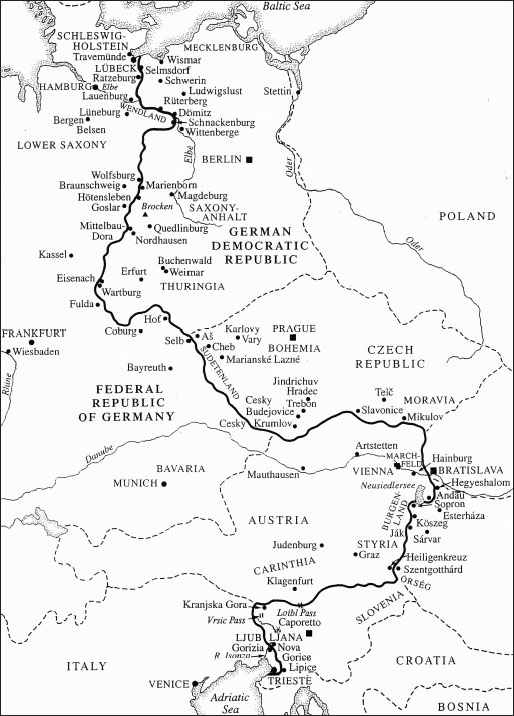
The Iron Curtain

Hand-made comb-marbled paper by Ann Muir

A page from Gutenberg’s forty-two-line Bible
At the beginning of his famous novel The Naked Lunch (1959), William Burroughs includes what he calls a ‘deposition: a testimony concerning a sickness’ (my copy of the book, a nice tight hardback, with original dust jacket, published by John Calder, was bought secondhand from an old junkshop in Chelmsford that I used to visit with schoolfriends at weekends in search of cheap paperback Beats, and Jean-Paul Sartre, and Albert Camus, and the Picador Richard Brautigan, and Borges, and Philip K. Dick). Burroughs is writing about his fifteen-year addiction to ‘junk’ – opium and all of its derivatives, including morphine, heroin, eukadol, pantopon, Demerol, palfium and a whole load of other stuff that he had variously smoked, eaten, sniffed, injected and inserted. ‘Junk,’ Burroughs writes, ‘is the ideal product … the ultimate merchandise. No sales talk necessary. The client will crawl through a sewer and beg to buy … The junk merchant does not sell his product to the consumer, he sells the consumer to his product … The addict … needs more and more junk to maintain a human form … [to] buy off the Monkey.’
The chances are, if you are reading this book, you are no better or worse than William S. Burroughs. The chances are, you have a serious problem: you’re an addict. You have been sold to a product. You have a monkey on your back. And that monkey is made of paper.
(But it’s OK. You are not alone. Here’s where I’m at: I am wearing a pair of dirty, brown, broken slip-on boots that my sister bought for me about ten years ago; in both boots the sole is split right across the middle, and I have attempted to fix them with super-glue. I have two other pairs of shoes, but they too are broken, too broken in fact for me to be able to patch up, and they have therefore required professional attention and are currently awaiting collection from the excellent boot and shoe repair shop – motto, ‘Shoes Good Enough To Wear Are Good Enough To Mend’ – just off Botanic Avenue in Belfast. I am wearing one of the shirts that the father of a friend of mine kindly sent me a few years ago, when he’d retired and was throwing out all his old work clothes and buying leisurewear. All of the shirts are made of a drip-dry nylon – Alagon – of a kind now unavailable for reasons not at all clear to me; you get used to the rashes after a while, and the benefit of not having to iron the shirts surely outweighs any slight skin complaint the material may cause. My trousers are one of the two wearable pairs that I’m currently running, and they’re in pretty good condition, although they are covered in green paint from a couple of summers ago when I was painting the shed where I work in the garden. My jacket is circa 1990. And I am standing in the War on Want bookshop, down at the other end of Botanic Avenue, ostensibly on my way home from work, and I have half a dozen books in my arms, and I know that if I blow all of my £20 spending money on these books I won’t be able to get my shoes back from the cobbler, and I’ll have to leave them there another week. They’ve already been in for a month, and the proprietor of the shop has started leaving messages for me on my answerphone. I have a decision to make. I buy the books. For the foreseeable future I shall continue to be dressing like a vaudeville comedian, or a character in a play by Samuel Beckett.)
The first documented use of the word bibliomania, according to my OED – the twenty-volume second edition, bought as a present to myself when I received the advance on my first novel, and which cost me the advance on my first novel, which meant effectively that I wrote a book to buy a book – was in 1734, in the Diary of Thomas Hearne
Конец ознакомительного фрагмента.
Текст предоставлен ООО «ЛитРес».
Прочитайте эту книгу целиком, купив полную легальную версию на ЛитРес.
Безопасно оплатить книгу можно банковской картой Visa, MasterCard, Maestro, со счета мобильного телефона, с платежного терминала, в салоне МТС или Связной, через PayPal, WebMoney, Яндекс.Деньги, QIWI Кошелек, бонусными картами или другим удобным Вам способом.


